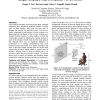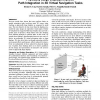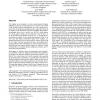6 search results - page 1 / 2 » With similar visual angles, larger displays improve spatial ... |
CHI
2003
ACM
14 years 5 months ago
2003
ACM
Large wall-sized displays are becoming prevalent. Although researchers have articulated qualitative benefits of group work on large displays, little work has been done to quantify...
APGV
2006
ACM
13 years 11 months ago
2006
ACM
Previous research has found performance for several egocentric tasks to be superior on physically large displays relative to smaller ones, even when visual angle is held constant....
CHI
2004
ACM
14 years 5 months ago
2004
ACM
Previous results have shown that users perform better on spatial orientation tasks involving static 2D scenes when working on physically large displays as compared to small ones. ...
APGV
2006
ACM
13 years 8 months ago
2006
ACM
Distances in immersive virtual environments (VEs) have been commonly reported as being spatially compressed while the same judgments are performed accurately in real space. Previo...
VRST
2009
ACM
13 years 11 months ago
2009
ACM
The display units integrated in todays head-mounted displays (HMDs) provide only a limited field of view (FOV) to the virtual world. In order to present an undistorted view to th...



